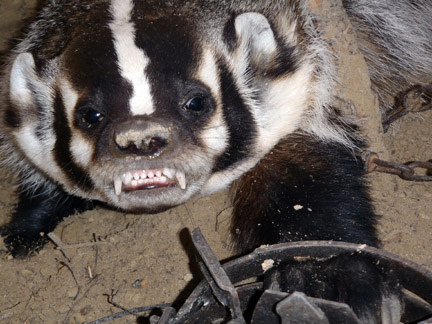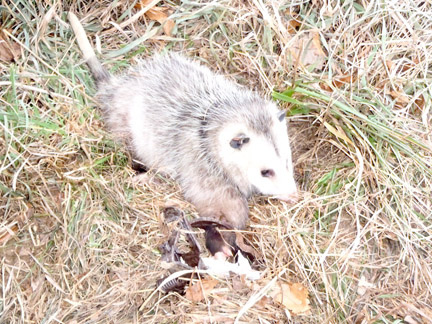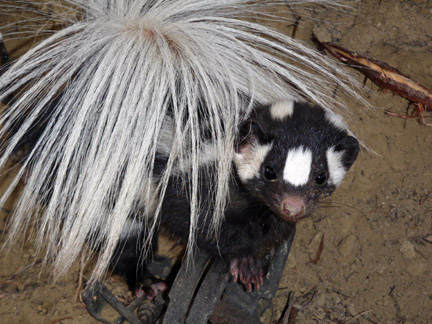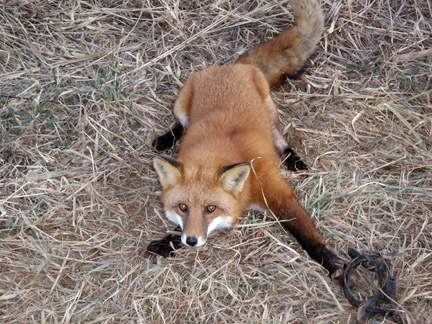



SD Nest Predator Bounty Program

Las Results from 2025 – Bounty Program produced 51,902 total tails or dead animals
Number of dead animals by target species (2025):
Raccoon – 41,204, Opossum – 6,913, Striped Skunk – 3,206, Badger – 334, Red Fox – 245
Dependent young of target animals, who died when parent(s) lost are not included in totals.
Link to SDGFP’s Tail Tracker web page – https://sdgfp.maps.arcgis.com/apps/dashboards/e7bbbd6fa93b48c6a31985aa7c57c5ff
ZOOM MEETING 11/19/25 – RECORDING AVAILABLE
Prairie Hills Audubon Society had a meeting on the Nest Predator Bounty Program by Zoom on
Wednesday 11/19/25, PHAS Nov. Members Zoom meeting on SDGFP Nest Predator Bounty Program .
PHAS will be promoting a bill in the 2026 legislature to stop the SDGFP’s annual Nest Predator Bounty Program (NPBP).
Alexey Egorov showed a powerpoint on the subject and we discussed legislative strategy and volunteer help needed to get this very adverse/wasteful program killed. Visit our web calendar for that date to learn about the meeting.
https://phas-wsd.org/event/phas-zoom-members-meeting-on-the-nest-predator-bounty-program-wed-nov-19th/ Most PHAS members meetings are recorded in full or in part, and links to the recording can be viewed on PHAS meeting’s recordings web page. https://phas-wsd.org/recorded-meetings/, However today that page is broken and I can’t up load to it.
However, here is the link to Alexey’s powerpoint video – Alexey’s recording on Nest Predator Bounty Program (NPBP) on Vimeo
================
Oppose The SD Nest Predator Bounty Program (NPBP)
ACTIONS NEEDED:
1. We are opposed to this program and want it stopped.
LEGISLATURE
2026 Activities
We will see to it that there is another bill in the 2026 legislature to stop the Nest Predator Bounty Program. Some folks have suggested alternate versions of the bill text for 2026.
At this point these three alternative bills are offered –
1) HB 1262 as amended (last years bill) https://phas-wsd.org/wp-content/uploads/HB1262.amended.pdf, Here is a link to a map of location of sponsors and co-sponsors. Rep Odenbach of District 31 and Sen. Taffy Howard of Rapid City were prime sponsors. https://phas-wsd.org/wp-content/uploads/Bill1262_sponsors_map.pdf The district boundaries show districts as mapped in 2020 and not as reshaped after redistricting in 2021 or 2022.
Two new versions of a bill are suggested
to prevent statutes in both title 40 and title 41 being used to allow SDGFP to fund the NPBP again.
2) One is less aggressive and limited to preventing bounties for the 5 target species for purpose of protection of ground nesting birds and thus easier to pass https://phas-wsd.org/wp-content/uploads/Nancys-sixth-version.PDF_NPBP.bill_.pdf and
3) one is more aggressive, and would prevent bounties on the 5 species or any reason, thus will have more impact but may be harder to pass https://phas-wsd.org/wp-content/uploads/AnAct2_ToSaveMillionsOfDollarsByEliminatingAWastefulAndInefficientBountyProgram-_loophole-free.pdf. .
Please contact your legislators and ask them to support 2026 year’s version of an anti-nest predator bounty bill, either with their votes or as a bill sponsor.
House Agriculture and Natural Resources —
https://sdlegislature.gov/Session/Committee/1225/Detail – E-mail – houseagnaturalresources@sdlegislature.gov
Marty.Overweg@sdlegislature.gov,
Spencer.Gosch@sdlegislature.gov, Julie.Auch@sdlegislature.gov,
Tim.Goodwin@sdlegislature.gov, Jana.Hunt@sdlegislature.gov,
Travis.Ismay@sdlegislature.gov, Trish.Ladner@sdlegislature.gov,
Kaley.Nolz@sdlegislature.gov, Drew.Peterson@sdlegislature.gov,
Kathy.Rice@sdlegislature.gov, Kevin.VanDiepen@sdlegislature.gov,
Richard.Vasgaard@sdlegislature.gov, Kadyn.Wittman@sdlegislature.gov
===========================
Senate Agriculture and Natural Resource
E-mail – senateagnaturalresources@sdlegislature.gov
curt.voight@sdleglislature.gov, helene.duhamel@sdlegislature.gov, kevin.jensen@sdlegislature.gov, michael.rohl@sdlegislature.gov, sam.marty@sdlegislature.gov, sydney.davis@sdlegislature.gov, tom.pischke@sdlegislature.gov
PHAS had been working very hard to get bill sponsors for a bill to stop the Nest Predator Bounty Program (NPBP) . In 2025 Rep Scott Odenbach volunteered to be prime sponsor of such a bill and he and the SD LRC a revision of a draft bill we provided him with. IN 2025 Senator Taffy Howard volunteered to be senate sponsor. Repl Odenbach’s bill would have killed the NPBP. PHAS supported the bill, as it would have stopped the NPBP (see sections 1 & 2 were the NPBP will be stopped) , and we are very thankful to Rep. Odenbach.
Prairie Hills Audubon Society had two draft bills to kill the Nest Predator Bounty Program (NPBP) and we asked people to help contact SD legislators to get them to oppose the Nest Predator Bounty Program. Thanks to all who volunteered to contact legislators. Here is material we sent to legislators in 2025
BACKROUND MATERIAL:
Introductory comments about need for bills – for e-mail text: – 1 page (3 paragraphs)
https://phas-wsd.org/wp-content/uploads/Short-anti-NPBP-statementx2.pdf
Generic Letter to a SD legislator asking her/him to be a bill sponsor of anti-Nest Predator Bounty Program bill – 2 pages long
https://phas-wsd.org/wp-content/uploads/01Generic_Long_Letter_to_Legislatorwhite.pdf
Appendix to letter ( Talking points – Long Version of – 4 pages of arguments against the NPBP)
https://phas-wsd.org/wp-content/uploads/02Appendix2_to_Legislator_letter_finalx.pdf
————–
FOR MORE INFO
Please feel free to contact us directly – Alexey Egorov at (605)736-3929 alexey.egorov.jr@gmail.com or Nancy
Hilding, phas.wsd@rapidnet.com or nhilshat@rapidnet.com, (605)787-6466 land line,
(605)787-2806 cell. Nancy and Alexey wrote this legislative material together.
Shorter Earlier Version of talking points (2 pages):
https://phas-wsd.org/wp-content/uploads/NPBP-talking-points-Jan-23rd_2.pdf
=====================
CONTACT CANDIDATES
BACKGROUND
Striped Skunks =3,800
Badger = 387
Red Fox = 276
Opossums = 16,700
==
MEDIA
===========
Here is a link – to a November 2023 Newswatch article on this issue titled “South Dakota predator bounty program to continue despite opposition”
https://www.sdnewswatch.org/south-dakota-nest-predator-bounty-program-raccoons-pheasants
Here is a link to SD Searchlight Article on legislative committee discussing the Nest Predator Bounty Program
SD Searchlight on House Agriculture and Natural Resources Committee interviewing Sec Kevin Robling on the Nest Predator Bounty Program in 2024
============
Summary of Public Opinion Letters sent to SDGFP
The public opinion letters sent to SDGFP about the NPBP were over 90% against the NPBP
Review of public comments sent to GFP – review by Alexey Egorov
https://phas-wsd.org/wp-content/uploads/06Review-by-ALexey-EgorovPublicComments_final.docx
PUBLIC OPINION SURVEY
URL Link to to Remington Research Group’s 2020 statewide public opinion survey on the NPBP: https://phas-wsd.org/wp-content/uploads/HSUS_pred_survey.Remington.pdf
=============
TRAPPING FACTS/BACKGROUND
In the fur pelt market as per ” Trapping Today” in 2023/2024
1. the price for most raccoon pelts won’t be as much as $5, unless large pelt, in which case it could bring 5-10 dollars,
2. Red fox pelts are a niche market product and usually average about $10-15
3. Skunks are a traditional novelty market, and should get $10-15..
4. Badger are being harvested in very limited quantities. Badger prices have been strong at around $20 averages, and are expected to stay that way.
5. There was no price offered for opossum pelts.
https://www.trappingtoday.com/2023-2024-fur-prices-trapping-todays-fur-market-forecast/
We assume theses prices are for winter pelts, which are thicker
At this link see the average price for furs received in SD in 2022-2023
https://gfp.sd.gov/fur-harvest/
==============================
JAN 13th, 2023 UPDATE – 4 MORE YEARS
SD Game, Fish and Parks Commission on Friday, January 13th 2023 approved 4 more years of the Nest Predator Bounty Program at $500,000 per year and $10 per tail. The resolution (23-01) passed unanimously. Here is a link to the resolution: https://phas-wsd.org/wp-content/uploads/RES_23-01_-_2023_to_2026_Nest_Predator_Bounty_Program_Resolution.pdf On Thursday 3 folks testified against the Program – Nancy Hilding for PHAS and Julie Anderson and Jamie Al-Haj. PHAS had a Zoom evening meeting to discuss this and other issues on April 30th, 2023 .
When SD Game, Fish and Parks Commission on January 12th or 13th 2023, it considered the resolution to refund the Nest Predator Bounty Program for 4 years. It was expected that the resolution , would look like the one they passed 2 years ago – funding two years of the program: https://gfp.sd.gov/UserDocs/nav/21-06_Resolution-_Nest_Predator_Bounty_Program_-_2021_and_2022.pdf This approved $500,000 for each year and bounties of $10 per tail. However they surprised us and approved the program for 4 years.
You could have testified against the Program for 3 minutes (or less) during the “Open Forum” (You still can at future meets). For instructions on how to testify for the next Commission meeting see our events page).
================================================
HISTORY – PHAS MEETING ON NPBP Nov. 2023
PHAS had a meeting on raccoons & SDGFP management of meso-carnivores 11/29/23 . It discussed the NPBP. It’s recording and other past
PHAS meeting’s recordings are available on our web page on our meeting recordings.
https://phas-wsd.org/recorded-meetings/
PHAS has periodic conservation discussion meetings for members, that are not recorded, but are announced on our web and Facebook pages.
===============================
LONGER TERM HISTORY – 4 Previous years
SD Game, Fish and Parks (SDGFP) created a bounty program for nest predators in 2019 and has offered 3 years (2019, 2021 & 2022) of the program – funded at a $500,000 expenditure for bounties at $10 per tail and 1 year (2020) funded with $250,000 in bounties at $5 per tail. The first year SDGFP gave away free traps. Target animals are – raccoons, opossums, striped skunk, red fox, badger. The first year (2019) the live trap give-away program cost $958,171, the payment for tails cost $547,400, salaries/benefits cost $190,915 & miscellaneous expenses cost $35,778 – Thus 2019’s total cost was $1,732,264.
The expenditures are normally approved by the GFP Commission in the first few months of the year and while times of the bounty season have varied – the 2022 bounty ran from March 1 till July 1st. (The first month was for youth). The 2022 Season ended on July 1st and they took 49,778 tails, with raccoons being caught the most, followed by striped skunk and opossums as most caught.
We oppose this – The NPBP was originally sold as a way to increase pheasant numbers and then also increase other ground nesting birds. As that was not very credible, they added inspiring youth to take up trapping as a program goal. It is ineffective at protecting eggs/nestlings and is cruel. Why do we want to spend at least 3 million dollars over 4 years inspiring children to trap? It is a waste of SDGFP money, that could be better spent on other projects.
One of Kristi Noem’s justifications for Merging DENR into Agriculture Department (creating DANR) was to save about $500,000 a year. She was wasting that annually inspiring kids to trap with a useless & harmful bounty program .
Here is a link to recent (fall 2023) article by SD News Watch on this issue:
OLD ALERT
This page is being written and is evolving. We plan to update, rewrite & move the old alert on the SD Nest Predator Bounty Program (NPBP) that exists on our Blog page. For now our old alert can be found at https://www.blogger.com/blog/post/edit/4368376858740594690/6395956365739341594 but you have to scroll past the otter section to reach the NPBP section.
TAKE ACTION WITH ADMINISTRATION
Tell the SDGFP Commission that you object to the NPBP. Tell the Governor you object (she is a very very strong promoter of it & appoints the Commissioners and hires/fires staff). On our events page we post the dates of upcoming Commission meetings and how to contact the Commissioners. You can get 3 minutes to testify at any Commission meeting. You can write to them. We need people to show up year round and object to the Nest Predator Bounty Program.
You can write to the Commission at any point and/or attend Commission meetings face-to-face or virtual and testify
for 3 minutes.
BASIS IN LAW
Because of SDCL 40-36-9, SDGFP can give away free traps, set bounties and allocate money as an administrative action — legislative approval, formal rule making and a public hearing are not required. Ask your legislator to change this law (SDCL 40-36-9) and remove or limit the SDGFP Department’s authority to set bounty programs and decide to spend 1.7 million in just one year on such a wasteful & harmful program.
SDCL 40-36-9. Programs and rules for control of injurious animals–Payment of expenses. The Department of Game, Fish and Parks may direct or employ personnel and conduct programs and the Game, Fish and Parks Commission may adopt pursuant to chapter 1-26 necessary rules to control foxes, coyotes, feral dogs, prairie dogs, and other wild animals. The expense thereof shall be paid out of the Department of Game, Fish and Parks fund or the state animal damage control fund.
Source: SDC 1939, § 25.1004; SL 1974, ch 274, § 2; SL 1978, ch 288, § 5; SL 1983, ch 292, § 10; SL 1984, ch 273, § 36.
———————————————————————————————————–
–———————————————————————————————————-
WHY OPPOSE? (see also talking points at the start of the web page)
– Empathetic children may encounter moral dilemmas such as how to kill the 12 or 13 babies in an opossums pouch, and later learn that they did this killing of babies, based on lies told them by SD GFP about effects of a bounty program on nesting success. How does this engage children with nature or give them trust in government?
HERE IS A NEW PETITION AT CHANGE.ORG AGAINST THE NPBP TO SIGN (CREATED MAY 2024)
Folks put up national petitions six years ago to collect signatures against the program. The introduction to the petitions is dated (6 years old), but the signatures were presented to the Commission on Thursday 1/12/23.
Past years SDGFP furbearer reports – learn about trapping statistics in our state
2022-2023 fur harvest report: https://gfp.sd.gov/fur-harvest/
https://gfp.sd.gov/UserDocs/nav/-_2023_Furbearer_Annual_Report.pdf – 2023
https://gfp.sd.gov/UserDocs/nav/2022_Furbearer_Annual_Report.pdf – 2022
https://gfp.sd.gov/UserDocs/nav/-_2021_Furbearer_Annual_Report.pdf — 2021
https://gfp.sd.gov/UserDocs/nav/-_2020_Furbearer_Annual_Report2.pdf — 2020
https://gfp.sd.gov/UserDocs/nav/-_2018_Furbearer_Annual_Report.pdf – 2018
https://gfp.sd.gov/userdocs/docs/wdm2022_annualreport.pdf
=============
HSUS FACT SHEET ON NPBP, Likely 2019 or 2020
https://phas-wsd.org/wp-content/uploads/HSUS_SD-bounty-ban-factsheet.pdf
LINKS ON PREDATOR CONTROL AND PHEASANTS/DUCKS
• We refer you to Pheasants Forever’s web page on “Effects of Predators”,
https://www.pheasantsforever.org/Habitat/Pheasant-Facts/Effects-of-Predators.aspx
• • Ducks Unlimited’s web page on “Ducks, Habitat Conservation & Predators”
• Also see page 11 of SD GFP’s Pheasant Management Plan 2016–2020, in the section on predators that says: “Where predator control may be considered as a management option, managers should be aware that cost, logistics, and lack of effectiveness often limit success when compared to habitat management. (emphasis added) Entire Plan: – ”https://gfp.sd.gov/UserDocs/nav/pheasant-mngmnt-planpdf.pdf
Just page 11: https://phas-wsd.org/wp-content/uploads/Pred.Control.page11-OLD.pheasant-mngmnt-plan.pdf
=============
2025 FORMERLY SUGGESTED BILLS
THIS IS HISTORY – Odenbach and LRC chose bill 1262 in 2025, that is slightly different from these suggested version, but achieves purpose of the “Simple Bill”
(The simple one was rewritten into HB 1262):
URL –Simple Bill – “just say no’ (not used)
https://phas-wsd.org/wp-content/uploads/04Bill_JustSayNoToNPBP_finalX.pdf
URL- More Broad Bill with greater impact (not used0
https://phas-wsd.org/wp-content/uploads/Stop-NPBP-broader-impact-version2.pdf
====
Meeting on
2026 Legislative Effort
Prairie Hills Audubon Society’s 11/18/25 presentation on the SDGFP’s Nest Predator Bounty Program (NPBP) –
FIRST HALF – Link to the recording stored on Vimeo.:
https://vimeo.com/manage/videos/1138972611
Alexey Egorov gives a presentation on SD Game Fish & Park’s Nest
Predator Bounty Program. Prairie Hills Audubon Society opposes SDGFP’s
Nest Predator Bounty Program (NPBP) as an ineffective program that does
not work to protect ground nesting birds and has been a waste of likely
4.9-5 million dollars over a history of 7 years. GFP offers $10 bounties
for tails of the 5 target mesopredators/omnivores, that are presented
to them.
This money could be spent to benefit ground nesting birds by
investing in habitat, which would actually work to protect and increase
ground nesting birds. Matching federal funds are available for habitat
protection/improvements.
Trapping of wildlife during their breeding and child rearing seasons,
increases the cruelty impacts, as dependent young also die. SD has trap
check times of 3 and a partial day west River and 2 and a partial day
east River. Alexey Egorov is the Author of the Powerpoint.
====t
SECOND HALF -here is a second part to this meeting where attendees
discuss strategies to get the NPBP terminated. Links to recordings of
our working meetings (where strategies are discussed) are not posted to
the internet. If you want such a copy, contact Nancy directly –
605-787-6466 or phas.wsd@rapidnet.com. We limit sharing of links to
strategy meeting recordings to people who support our
objectives/platforms.
=====
==
Lorem ipsum dolor sit amet, consectetur adipiscing elit. Ut elit tellus, luctus nec ullamcorper mattis, pulvinar dapibus leo.